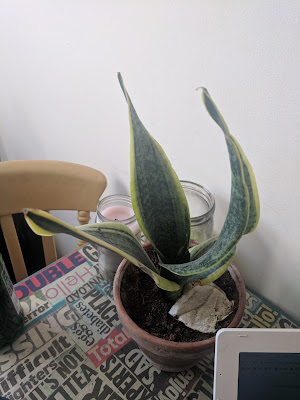Snake plants are mysterious and majestic and therefore one of my favourites. Technically they're a succulent, but larger and more imposing that indoor succulents tend to be and if you believe everything you read, unkillable. I've killed one though, so that's false. It died from over-watering. So it goes.
I've bought a good few plants from Flourish in Manchester now - they have an outdoor stall at the Piccadilly end of Tib Street as well as a smaller shop further up the street, making it very difficult to walk past them and come out the other side empty handed. I've two snake plants on the go from them right now, this one:
that lives in my front room; and this one:
that lives in my bedroom. Here's a third one, that I picked up from Wilko's in Bury over the weekend for £2.50, a bargain:
Here are two things about snake plants I feel you should know:
1. They are very aesthetically delicate. Something about the way the spiky leaves bend and twist just looks right as they do so together, pushing their way upwards from the densely packed and potted rhizome. (See this smashing post at Joy Us Garden for an example of what's going on under the soil). Apparently snake plants like this kind of confinement: pot them in a space too large and they become weak and undisciplined. What all this means is that when it comes to choosing a leaf to remove for propagation, you have to select very carefully. Cut the wrong one, and the whole plant ends up looking inexplicably, irreversibly wrong. I don't understand plants enough to articulate why this is, but it is obviously true. Feng shui, but with plants instead of furniture. It's probably already an ancient art. This brings us to...
2. They can be propagated from leaf cuttings, but they don't have to be. This, however, is the method I want to succeed at. (They can be propagated by carefully dividing the rhizome when re-potting a larger plant). There's an excess of video tutorials on YouTube on this very subject, which I have followed scrupulously before (or so I thought) to little avail. Here is a cutting a leaf I've been allowing to "callus" over in my room now for a few weeks:
Despite only giving the cuttings a drop of water for the first few days after callusing, the top part of the leaf has become damp and useless. Neither half shows any sign of roots. All this could be to do with the time of year, perhaps, but it's most certainly spring now, and it's a beautiful sunny day today so if now isn't the time to try again, I don't know when it will be.
So, I have carefully selected two leaves, one from my living room plant and one from the Wilko plant that currently sits on my dining table. The bedroom plant, with its curved and spiky eccentricities, just wouldn't even let one leaf go. Nothing looked right. So:
and:
have given me:
One half of one leaf remains from the earlier cutting (left) and now accompanies one leaf from each of the two plants, divided in half. When it comes to rooting, putting the cuttings the right way up is essential, so I have placed these all facing the same way, to remind me which way is up.
For this experiment, I will be leaving to callus fully before rooting the leaves in small pots, and leaving for several days without any water. After that, I'll water as often as I will the parent plants (about every six weeks, as Flourish have advised) and see how things go from there. I will report back then with my results.
Appreciate a plant today. Thank you.




Related posts
Prayer Plant Propagation
Prayer Plant Progress
My Windowsill Herb Garden
See all posts labelled, 'indoor-gardening'
Please consider disabling your adblockers when reading this site. I make every effort to ensure no inappropriate, rubbish or offensive advertising appears here, and nothing that is contrary to the spirit of this blog. So it's really nothing to be afraid of. Cheers.







Comments
Post a Comment
Your comments are welcome.